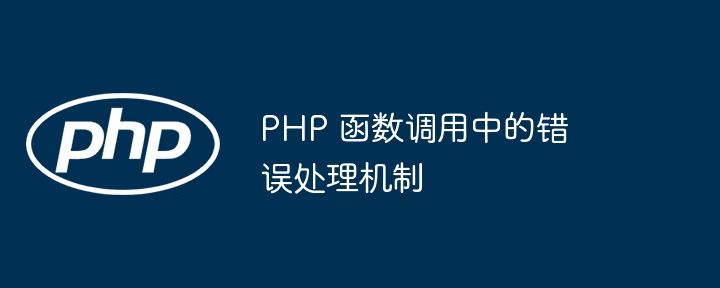Error handling mechanism in PHP function calls
PHP provides an error handling mechanism to capture and handle errors in function calls, including syntax errors, runtime errors and logic errors. By using the trigger_error(), set_error_handler(), and restore_error_handler() functions, developers can create custom error handlers to catch errors and take appropriate actions, such as logging or throwing exceptions, to ensure the robustness and reliability of the application .

Error handling mechanism in PHP function calls
PHP provides a powerful error handling mechanism that can help developers capture and Handle errors in function calls. This is critical to creating robust and reliable applications.
Error Types
PHP errors can be divided into three main types:
- Syntax errors: During parsing Errors that occur when coding, such as missing semicolons or unmatched curly braces.
- Runtime Error: An error that occurs while executing code, such as trying to access an undefined variable or exceeding the scope of an array.
- Logic Error: An error that occurs due to a flaw in the logic of the code, such as user input not being properly validated.
Error handling function
PHP provides several built-in functions to handle errors:
- trigger_error( ): Raises a custom error message.
- set_error_handler(): Set a user-defined error handler.
- restore_error_handler(): Restore the default error handler.
Practical Case
The following is a practical example of how to use error handling in a function call:
<?php
// 定义一个抛出错误的函数
function divide($dividend, $divisor)
{
if ($divisor == 0) {
trigger_error('Division by zero', E_USER_ERROR);
}
return $dividend / $divisor;
}
// 设置一个自定义错误处理程序
set_error_handler(function($errno, $errstr, $errfile, $errline) {
echo "Error: $errstr in $errfile on line $errline";
});
// 调用函数并处理可能发生的错误
try {
$result = divide(10, 5);
echo "Result: $result";
} catch (Error $e) {
echo "Caught error: " . $e->getMessage();
}
?>In the above example , divide() function will throw an error when the divisor is zero. A custom error handler catches the error and prints the error message.
Conclusion
PHP’s error handling mechanism enables developers to effectively capture and handle errors in function calls. This is critical to building robust and reliable applications.
The above is the detailed content of Error handling mechanism in PHP function calls. For more information, please follow other related articles on the PHP Chinese website!

Hot AI Tools

Undresser.AI Undress
AI-powered app for creating realistic nude photos

AI Clothes Remover
Online AI tool for removing clothes from photos.

Undress AI Tool
Undress images for free

Clothoff.io
AI clothes remover

AI Hentai Generator
Generate AI Hentai for free.

Hot Article

Hot Tools

Notepad++7.3.1
Easy-to-use and free code editor

SublimeText3 Chinese version
Chinese version, very easy to use

Zend Studio 13.0.1
Powerful PHP integrated development environment

Dreamweaver CS6
Visual web development tools

SublimeText3 Mac version
God-level code editing software (SublimeText3)

Hot Topics
 1359
1359
 52
52
 CakePHP Project Configuration
Sep 10, 2024 pm 05:25 PM
CakePHP Project Configuration
Sep 10, 2024 pm 05:25 PM
In this chapter, we will understand the Environment Variables, General Configuration, Database Configuration and Email Configuration in CakePHP.
 PHP 8.4 Installation and Upgrade guide for Ubuntu and Debian
Dec 24, 2024 pm 04:42 PM
PHP 8.4 Installation and Upgrade guide for Ubuntu and Debian
Dec 24, 2024 pm 04:42 PM
PHP 8.4 brings several new features, security improvements, and performance improvements with healthy amounts of feature deprecations and removals. This guide explains how to install PHP 8.4 or upgrade to PHP 8.4 on Ubuntu, Debian, or their derivati
 CakePHP Date and Time
Sep 10, 2024 pm 05:27 PM
CakePHP Date and Time
Sep 10, 2024 pm 05:27 PM
To work with date and time in cakephp4, we are going to make use of the available FrozenTime class.
 CakePHP Working with Database
Sep 10, 2024 pm 05:25 PM
CakePHP Working with Database
Sep 10, 2024 pm 05:25 PM
Working with database in CakePHP is very easy. We will understand the CRUD (Create, Read, Update, Delete) operations in this chapter.
 CakePHP File upload
Sep 10, 2024 pm 05:27 PM
CakePHP File upload
Sep 10, 2024 pm 05:27 PM
To work on file upload we are going to use the form helper. Here, is an example for file upload.
 CakePHP Routing
Sep 10, 2024 pm 05:25 PM
CakePHP Routing
Sep 10, 2024 pm 05:25 PM
In this chapter, we are going to learn the following topics related to routing ?
 Discuss CakePHP
Sep 10, 2024 pm 05:28 PM
Discuss CakePHP
Sep 10, 2024 pm 05:28 PM
CakePHP is an open-source framework for PHP. It is intended to make developing, deploying and maintaining applications much easier. CakePHP is based on a MVC-like architecture that is both powerful and easy to grasp. Models, Views, and Controllers gu
 CakePHP Creating Validators
Sep 10, 2024 pm 05:26 PM
CakePHP Creating Validators
Sep 10, 2024 pm 05:26 PM
Validator can be created by adding the following two lines in the controller.




